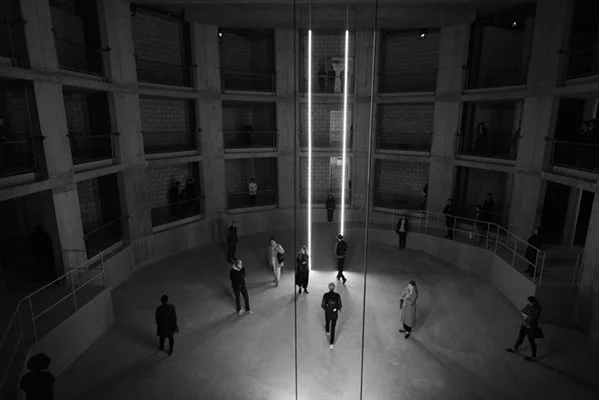Review: An Occupation of Loss | Wilma
Courtesy Taryn Simon
A version of this review first appeared in Wilma Journal (active 2018-2019)
We leave the busy sounds of Essex Road while dusk is still falling. The audience is led to the third floor of a barren cathedral space with a blue-tinted skylight. Peering below, we see an empty space with ramps leading to the centre. Each ramp has thin LED lighting creating an entrance and focus in the increasing darkness. Before we can consider its purpose we hear the deep bass of drum beats as performers enter the space in twos and threes, eventually disappearing into recesses on all three floors. Sounds of chanting begins to emerge from unseen corners. The sounds layer over each other and bounce off the cement walls.
The first corner I turn reveals two seated figures concealed with capes. I can’t see their faces but their plaintive singing voices suggest they are female. I make my way round and find a lone, blind accordion player, stood high on a platform. And on it goes with each twist and turn, we are spectators to lamentation from professional mourners. The audience wanders wordlessly.
“...we’re asked to witness the authenticity of the moment but are not privy to the loss. ”
This is ‘An Occupation of Loss’. Originally staged in New York in 2016 by artist Taryn Simon to incorporate architecture, performance and sound, the piece explores the experience of grief. Following a lengthy period of research into professional mourning, speaking to musicologists, linguists, historians and anthropologists, Simon began organising the travel of 21 international mourners to the US, and this year to the UK. This process is documented in a book that brings together the visa applications, supporting documents from academics and cultural history of mourning, exposing the bureaucracy of movement and value of art and culture across borders – particularly from post-Trump countries of scrutiny.
The concept came to Simon’s through an interest in the rituals of death and grieving in the US and UK. In The Independent, Simon’s explains how “we respond privately, nationally, civically to loss. You’re also confronting the moment that will be unprecedented”.
Courtesy Taryn Simon
The experience itself is at once sobering and strange. The audience respectfully watches the mourners put voice to a grief in languages and emotions that may be alien to most. It feels somewhat voyeuristic to observe people submerge into grief - a grief that has no focus in a space that has no visible ‘loss’ at its centre. Despite the magnitude and sincerity of the outpouring, these mourners rarely know the deceased in question. They perform a role - hired to express the sadness of the occasion through their voices and execute the stages of grief. They embody and amplify the very real tears of the loved ones left behind; shaping their sadness in a way only the human voice can express. In this context, we’re asked to witness the authenticity of the moment but are not privy to the loss.
The experience of the performance isn’t to be found in the chanting voices themselves but the personal journey our mind takes. For some, the journey may be instant and tangible, a recent bereavement may foster a kinship to the mourner expressing their silent tears. For others, the unfamiliar wailing will express an intangible void, as we try to fill it with a sense of empathy for the people we will never meet.
As the last voice recedes into the darkness, we’re left alone in a meditative trance, to quietly reflect upon the universal language of grief.
An Occupation of Loss is on view till 28th April 2018.

